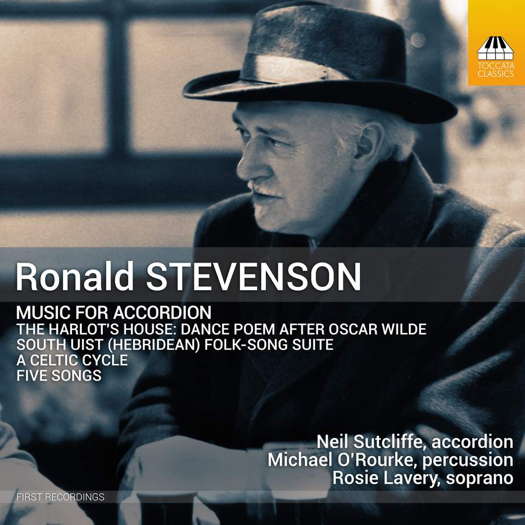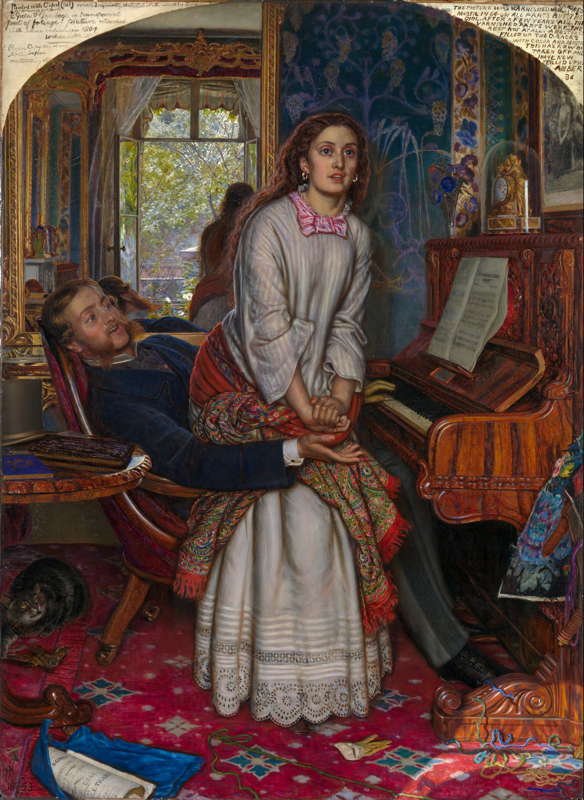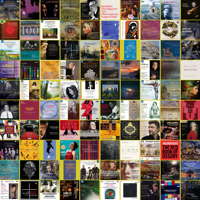- Terry Riley
- Umberto Giordano
- Enescu
- EUCO
- Heart of England Orchestra
- William Carragan
- Robert Hitchens: The Garden of Allah
- Carlos Païta

Precious, Luminous Gems
ESDRAS MUGATIK listens to music for accordion by British composer Ronald Stevenson (1928-2015)
'... beautiful works, beautifully performed ...'
In the World Tales rendition of Mushkil Gusha by Idries Shah, an aged woodcutter is magically transported to a desert landscape strewn with pebbles of many colours. Told by a mysterious voice to gather as many as he can carry he returns to this world and in a time the stones are transformed into 'precious, luminous gems'. Eventually, after numerous tribulations, all live happily afterwards.
After having traversed far-flung realms of music, Ronald Stevenson has left for us these same gems in this world. He was himself a consummate transcriber (in the tradition of Bach, Liszt and Busoni) and along with his original works, he produced a vast body of music. Thus, it is no difficulty to learn that some of his own works have been transcribed for other forces than he originally conceived. It suits his practice well.
This lovely and introspective recording presents an interesting sidelight to Stevenson's creativity. Long considered the bane of a child's life, the accordion is not merely the adjunct to polka bands. The accordion virtuoso Myron Floren of the Lawrence Welk Orchestra and TV shows proves something of the level of virtuosity that can be attained. Indeed, when I visited the Soviet Union in the later 1970s I heard a young accordionist perform selections from Mussorgsky's Pictures at an Exhibition for solo accordion. His musicianship and virtuosity were an illumination. It was also completely unexpected. Heavy metal accordion is another matter. (For that see the metal band Turisas from Finland.)
But, here in Stevenson's composition The Harlot's House (composed 1988), the accordion is a very modern instrument. The poem by Oscar Wilde is recited before the performance and acts as a template for the work's progress in the manner of a symphonic elaboration. One can almost imagine the recitation inserted into the music performance, but that was not the composer's plan. Instead, we hear a slow and gentle process of sonic description of the text without obviousness and with a lightness of touch that almost evaporates. You would be hard pressed to realize that the underlying theme used is the famed Dies Irae. This is not music for listening while jogging, or driving, or in a London Tube. Yet, what it says is moving and touching without exaggeration. This is music for a moonlit night and the silence of countryside. Then we might hear Stevenson's careful delineation of the poem and above all, it's moral intent.
The performance here is amazing from both instrumentalists and the sonic visions they create are remarkable and subtle. Neil Sutcliffe on accordion is a superb musician with a truly great sense of musical rhythm which results is beautiful and moving phrasing.
Listen — Ronald Stevenson: Sailing Song (South Uist Folk-Song Suite)
(TOCC 0658 track 16, 0:28-0:48) ℗ 2023 Toccata Classics :
In a word, Michael O'Rourke is a wonderful percussionist. The blend of the accordion and percussion is ideal and one can only imagine the care and concern that went into the preparation.
Listen — Ronald Stevenson: Tempo di Valse (The Harlot's House)
(TOCC 0658 track 4, 0:00-0:25) ℗ 2023 Toccata Classics :
This is not a composition for a rave, or for a field at Glastonbury or a concert with forty vertical feet of amplifiers. It is a work for introspection which ought to make one ponder the message of Wilde - who certainly knew of what he spoke.
Listen — Ronald Stevenson: Totentanz (The Harlot's House)
(TOCC 0658 track 11, 0:21-1:00) ℗ 2023 Toccata Classics :
For we have entered into the House of Depravity and made it the norm for our culture. The American TV personality and composer Steve Allen wrote a book entitled Vulgarians at the Gate (2001). Wilde foresaw this, Stevenson comments upon it and our culture has drowned in a wash of pornography and tsunami of lust. There is a lesson not learned and if listening to Stevenson's music drives someone to reconsider their behaviours, then the music has achieved its moral goal. For I believe music without a moral goal will descend quickly into squalor.

The 1853 oil-on-canvas painting
The Awakening Conscience by Pre-Raphaelite
English painter William Holman Hunt (1827-1910)
Neil Sutcliffe also displays his talents as a transcriber making versions for the accordion of Stevenson's South Uist (Hebridean) Folk-Song Suite (1969) and further five songs from Stevenson's voluminous catalogue. They are beautifully done and Sutcliffe is joined for the song transcriptions by the wonderful soprano Rosie Lavery. Her tone is beautiful with controlled vibrato and she presents a lovely interpretation of these exquisite songs (or lieder, if you prefer, though Stevenson might have argued that word).
Listen — Ronald Stevenson: Day is Düne
(TOCC 0658 track 27, 0:01-0:36) ℗ 2023 Toccata Classics :
The excellent booklet even provides translations for the Scots words used in the text (for those not gifted in language).
The Celtic Cycle (1984-1988) is another work written expressly for the accordion by Stevenson. I find these utterly enchanting and subtle to the point of iridescent lucidity.
Enjoy these beautiful works, beautifully performed, but enjoy them in quiet, in simple immobility though perhaps with a soothing libation.
'To Ronald Stevenson!'
Copyright © 18 April 2024
Esdras Mugatik,
Carbonear, Newfoundland, Canada





